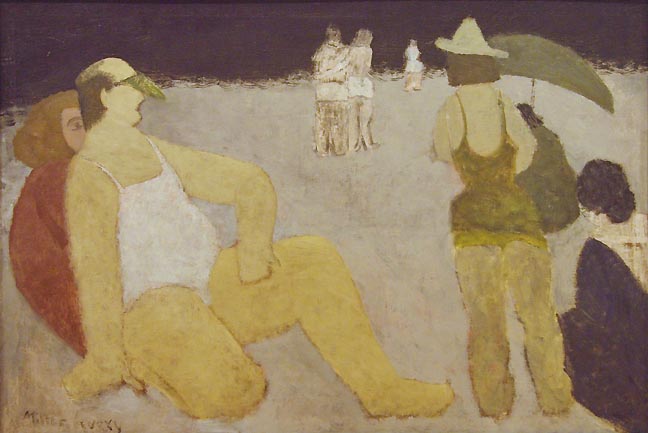
|
||
|
Portland art blog + news + exhibition reviews + galleries + contemporary northwest art
|
||
Free hours and an Avery depiction of Rothko First of all, everyone in Portland should know that tonight from
5-8 PM the Portland Art Museum will be open free of charge. It's a lovely
day and likely a lovely night out on the town to check out the Rothko Retrospective,
Joseph Beuys, John Frame etc. What's more the Portland Art Museum has more Rothko
on display than already advertised (I know how is that possible?).
 Milton Avery, Bathers Coney Island (1934) in the Portland Art Museum's collection Here is how... ever since I moved to Portland in 1999 I noticed a rather striking Milton Avery in PAM's collection called Bathers, Coney Island (1934). It is a good painting for an Avery beach scene, which are generally not regarded as highly as a more formal Avery portrait or landscape. regardless, what instantly got my attention was the large figure in the foreground with a green visor. Avery has painted this large man with a great deal of character and specificity, unlike every other figure in the scene. This implies a certain familiarity with the subject and I knew that in the mid 30's Rothko was very good friends with Avery who was in many ways his mentor at the time. The Averys and Rothkos often went out on beach outings (later on Rothko would give Avery's Eulogy). Then I noticed who had donated the painting to the museum, none other than Mr. and Mrs. J.M. Kaplan who were noted philanthropists and collectors of Avery/Rothko so it seemed possible. To my eyes that certainly looked like Rothko clowning around on the beach for his painter friends on the left. I brought up my Rothko guess in casual conversation with Bruce Guenther after we were on OPB's Think Out Loud discussing Rothko and he confirmed that the painting had come to the museum with a note indicating that that indeed the figure is is Rothko. For me it shows Rothko in a different light than we are used to seeing him, brooding, petulant and very very serious. In this case we see him playing the clown and enjoying life with good friends on the beach. I feel like it humanizes him and the Museum is very lucky to have the piece. In fact, informal portraits of very famous artists are one of my favorite genres but they are rare as even bar scenes are carefully staged to be iconographic. In the early 20th century artists were always trying to position themselves as icons and it wasnt until quite recently that David Hockney's devotees became en vogue that weve seen a break from the stoic mode. Posted by Jeff Jahn on March 23, 2012 at 13:12 | Comments (0) Comments Post a comment Thanks for signing in, . Now you can comment. (sign out)
(If you haven't left a comment here before, you may need to be approved by
the site owner before your comment will appear. Until then, it won't appear
on the entry. Thanks for waiting.)
|
| s p o n s o r s |
 |
 |
 |
 |
 |
 |
 |
 |
 |
 |
 |
 |
 |
 |
 |
 |

|
Site Design: Jennifer Armbrust | • | Site Development: Philippe Blanc & Katherine Bovee | |

